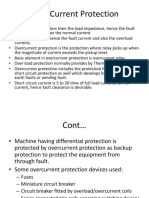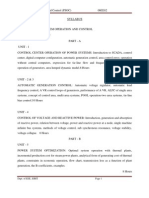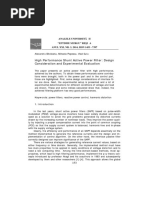Numerical Relay Protection of Transformer - PPT
Uploaded by
Muniyasamy BalaNumerical Relay Protection of Transformer - PPT
Uploaded by
Muniyasamy BalaNumerical Relay Protection Of Transformer
NUMERICAL RELAY PROTECTION OF TRANSFORMER
Krishnakanth. P Manindra. T Paul Dinakar. B Vijay. M 08241A0218 08241A0220 08241A0229 09245A0210
Guide: Vinay kumar. A
Assistant professor, EEE Department, GRIET.
Numerical Relay Protection Of Transformer
INTRODUCTION
Transformers are a critical and expensive component of the power system. Due to the long lead time for repair and replacement of transformers, a major goal of transformer protection is limiting the damage to a faulted transformer. Numerical relay protection of transformer is an advanced method of protection. The main aim of this project is to protect the transformer from the faulty conditions with in a short span of time. The type of protection for the transformers varies depending on the application of the transformer.
Numerical Relay Protection Of Transformer DIFFERENTIAL PROTECTION: Differential protection is a unit-type protection for a specified zone or piece of equipment. It is based on the fact that it is only in the case of faults internal to the zone that the differential current (difference between input and output currents) will be high. However, the differential current can sometimes be substantial even without an internal fault. This is due to certain characteristics of current transformers (different saturation levels, nonlinearities) measuring the input and output currents, and of the power transformer being protected. It is based on the fact that any fault within an electrical equipment would cause the current entering it to be different from the current leaving it. By comparing the two currents either in magnitude or in phase or in both, fault can be determined.
Numerical Relay Protection Of Transformer
NEED FOR PROTECTION:
Transformer is an extream device in power system which has 99.99% of efficiency. Improved power transformer protection using numerical relays, Large power transformers belong to a class of very expensive and vital components in electric power systems. If a power transformer experiences a fault, it is necessary to take the transformer out of service as soon as possible so that the damage is minimized. The costs associated with repairing a damaged transformer may be very high. So there is a necessity of protection of transformer.
Numerical Relay Protection Of Transformer
NEED FOR PROTECTION:
Here in this project numerical Relay ( Microprocessor Relay) plays a vital role to protect the large rating of power transformers. Fault detection and correction is necessary for the safe operation of transformer. Protection of large power transformers is perhaps the most challenging problem in the power system relaying. Here we are using numerical relay for the protection of Power Transformer.
Numerical Relay Protection Of Transformer
WORKING:
OVER LOADING PROTECTION: Initially the transformer is operated under normal condition the relay operation is absent. The transformer has a maximum safe current rating value for certain load, if the load is increased on the transformer then the load current is also increased. If the load current is exceeds the maximum rated current of the transformer then the relay will operate and the transformer is isolate from the main supply.
Numerical Relay Protection Of Transformer
DIFFERENTIAL PROTECTION: At normal operating condition the differential currents of CTs is zero. So here in this case the differential relay will not operate. As we know that the differential relay is operate only for internal fault condition. If the fault occurred in internal zone(between transformer and CTs) then a differential current flows in the relay, the relay is tripped and isolate the transformer from the mains.
Numerical Relay Protection Of Transformer
BLOCK DIAGRAM:
Numerical Relay Protection Of Transformer
COMPONENTS USED: Potential transformer(24/230v, 1A) Current transformer Auto transformer (0 to 270v) Data acquisition (DAQ USB-6009) Resistive load (15w bulb -2, 60w bulb -1)
Numerical Relay Protection Of Transformer
RESULTS:
When ever the fault occured on transformer the relay will trip. Numerical relay protection is a very fast acting,when comparing with other protection schemes. The output results are shown in figures.
Numerical Relay Protection Of Transformer
Numerical Relay Protection Of Transformer
Numerical Relay Protection Of Transformer
Numerical Relay Protection Of Transformer
Normal operating condition
Numerical Relay Protection Of Transformer
Numerical Relay Protection Of Transformer
Over loading condition
Numerical Relay Protection Of Transformer
Numerical Relay Protection Of Transformer
Before internal fault
Numerical Relay Protection Of Transformer
Internal fault condition
Internal fault condition
Numerical Relay Protection Of Transformer ADVANTAGES: 1. It is the simplest form of transformer protection. 2. It detects the incipient faults at a stage much earlier than is possible with other forms of protection. DISADVANTAGES: 1. It can only be the used with oil immersed transformer equipped with conservator tanks. 2. The device can detect only faults below oil level in the transformer. Therefore, separate protection is needed for connecting cables. CONCLUSION: Relay control output circuits of a much higher power. Safety is increased. Protective relays are essential for keeping faults in the system isolated and keep equipment from being damage.
Numerical Relay Protection Of Transformer
SCOPE:
This project aimed at providing protection to the transformer from numerical relay. This project can be used for many faults which are sensed by current. For overload protection of transformers this project is to be modified by using numerical relay. The actual operating current of transformer is monitored continuously and that is compared with the safe value of current limit. This project not only provides overload protection but also provides different charecteristics protection of transformer protection over wide range of faults whose presence can be known by numerical relay.
Numerical Relay Protection Of Transformer
THANK YOU
You might also like
- Protection of Alternator, Transformers, Bus Bar and Lines: Group 1100% (1)Protection of Alternator, Transformers, Bus Bar and Lines: Group 161 pages
- Lecture Presentaion On Generator, Transformer, Motor and Transmission Line Protection100% (1)Lecture Presentaion On Generator, Transformer, Motor and Transmission Line Protection44 pages
- Unit-1 PROTECTIVE RELAYING (Switchgear and Protection)No ratings yetUnit-1 PROTECTIVE RELAYING (Switchgear and Protection)76 pages
- Ac Circuit Breaker: 2.1 What Is Circuit Breaker?100% (2)Ac Circuit Breaker: 2.1 What Is Circuit Breaker?13 pages
- UNIT 4 Protection of Alternator and TransformerNo ratings yetUNIT 4 Protection of Alternator and Transformer16 pages
- Unit 4 - Static Relays and Numerical Protection 4.1 Static Relays100% (1)Unit 4 - Static Relays and Numerical Protection 4.1 Static Relays18 pages
- Power Transformer Protection ... Presentation100% (3)Power Transformer Protection ... Presentation17 pages
- Types of Faults in Electrical Power Systems and Their EffectsNo ratings yetTypes of Faults in Electrical Power Systems and Their Effects20 pages
- Buchholz Relay-Working, Construction, Application, Diagram, AdvantagesNo ratings yetBuchholz Relay-Working, Construction, Application, Diagram, Advantages5 pages
- Questions & Answers On Basic Materials & Transformer ConstructionNo ratings yetQuestions & Answers On Basic Materials & Transformer Construction20 pages
- Line Protection: Mahendra S Hada PowergridNo ratings yetLine Protection: Mahendra S Hada Powergrid48 pages
- 100 - Generator Stator Earth Fault ProtectionNo ratings yet100 - Generator Stator Earth Fault Protection10 pages
- A Brief Introduction To Essential Substation ComponentsNo ratings yetA Brief Introduction To Essential Substation Components16 pages
- Differential Relay: Under Electrical ProtectionNo ratings yetDifferential Relay: Under Electrical Protection5 pages
- ELR: ABB Range of Front Panel Residual Current Relays: Protection Device According To IEC/EN 60947-2 Annex M100% (1)ELR: ABB Range of Front Panel Residual Current Relays: Protection Device According To IEC/EN 60947-2 Annex M12 pages
- Inter Connecting Transformer Protection: Download App Install Read Books, Audiobooks, and More Scribd, IncNo ratings yetInter Connecting Transformer Protection: Download App Install Read Books, Audiobooks, and More Scribd, Inc4 pages
- Transformer Protection and Transformer FaultNo ratings yetTransformer Protection and Transformer Fault3 pages
- Restricted Earth Fault Protection of Transformer100% (1)Restricted Earth Fault Protection of Transformer2 pages
- Project Report of Transmission Type Eletrical Substation100% (5)Project Report of Transmission Type Eletrical Substation44 pages
- Numerical Relay Protection of Transformer PDF100% (1)Numerical Relay Protection of Transformer PDF19 pages
- Differential Protection of Transformer Using Arduino67% (6)Differential Protection of Transformer Using Arduino19 pages
- Switch Gear and Protection Unit 1 by Ramu. Srikakulapu100% (1)Switch Gear and Protection Unit 1 by Ramu. Srikakulapu75 pages
- Eee-Viii-power System Operation and Control (06ee82) - Notes100% (3)Eee-Viii-power System Operation and Control (06ee82) - Notes138 pages
- Cybenetics Evaluation Report Corsair CX650MNo ratings yetCybenetics Evaluation Report Corsair CX650M9 pages
- How To Set Up The DGC-2020HD For Paralleling in A Multiple Generator SetupNo ratings yetHow To Set Up The DGC-2020HD For Paralleling in A Multiple Generator Setup22 pages
- Foliage Penetration Radar. Detection and Characterization of Objects Under Trees - Mark E Davis100% (1)Foliage Penetration Radar. Detection and Characterization of Objects Under Trees - Mark E Davis374 pages
- Electrocardiografo IVY BIOMEDICAL 7800 (Manual)No ratings yetElectrocardiografo IVY BIOMEDICAL 7800 (Manual)53 pages
- 72F-Non Metallic Duct HDPE Cable-Technical Offer-18No ratings yet72F-Non Metallic Duct HDPE Cable-Technical Offer-186 pages
- Features General Description: 3A, 12V, Synchronous-Rectified Buck ConverterNo ratings yetFeatures General Description: 3A, 12V, Synchronous-Rectified Buck Converter21 pages
- Conexion y Programacion Panel VISTA48 MINI014GV2No ratings yetConexion y Programacion Panel VISTA48 MINI014GV23 pages
- SL No Operator Type Address Police Station/ Thana License No & Issue Date Licensee List of ISP Category-A100% (2)SL No Operator Type Address Police Station/ Thana License No & Issue Date Licensee List of ISP Category-A14 pages
- PHYS 475 Communication Electronics ii notesNo ratings yetPHYS 475 Communication Electronics ii notes44 pages
- Op Amps For MEMS Microphone Preamp CircuitsNo ratings yetOp Amps For MEMS Microphone Preamp Circuits9 pages
- Protection of Alternator, Transformers, Bus Bar and Lines: Group 1Protection of Alternator, Transformers, Bus Bar and Lines: Group 1
- Lecture Presentaion On Generator, Transformer, Motor and Transmission Line ProtectionLecture Presentaion On Generator, Transformer, Motor and Transmission Line Protection
- Unit-1 PROTECTIVE RELAYING (Switchgear and Protection)Unit-1 PROTECTIVE RELAYING (Switchgear and Protection)
- Unit 4 - Static Relays and Numerical Protection 4.1 Static RelaysUnit 4 - Static Relays and Numerical Protection 4.1 Static Relays
- Types of Faults in Electrical Power Systems and Their EffectsTypes of Faults in Electrical Power Systems and Their Effects
- Buchholz Relay-Working, Construction, Application, Diagram, AdvantagesBuchholz Relay-Working, Construction, Application, Diagram, Advantages
- Questions & Answers On Basic Materials & Transformer ConstructionQuestions & Answers On Basic Materials & Transformer Construction
- A Brief Introduction To Essential Substation ComponentsA Brief Introduction To Essential Substation Components
- ELR: ABB Range of Front Panel Residual Current Relays: Protection Device According To IEC/EN 60947-2 Annex MELR: ABB Range of Front Panel Residual Current Relays: Protection Device According To IEC/EN 60947-2 Annex M
- Inter Connecting Transformer Protection: Download App Install Read Books, Audiobooks, and More Scribd, IncInter Connecting Transformer Protection: Download App Install Read Books, Audiobooks, and More Scribd, Inc
- Project Report of Transmission Type Eletrical SubstationProject Report of Transmission Type Eletrical Substation
- Power System Wide-area Stability Analysis and ControlFrom EverandPower System Wide-area Stability Analysis and Control
- Differential Protection of Transformer Using ArduinoDifferential Protection of Transformer Using Arduino
- Switch Gear and Protection Unit 1 by Ramu. SrikakulapuSwitch Gear and Protection Unit 1 by Ramu. Srikakulapu
- Eee-Viii-power System Operation and Control (06ee82) - NotesEee-Viii-power System Operation and Control (06ee82) - Notes
- How To Set Up The DGC-2020HD For Paralleling in A Multiple Generator SetupHow To Set Up The DGC-2020HD For Paralleling in A Multiple Generator Setup
- Foliage Penetration Radar. Detection and Characterization of Objects Under Trees - Mark E DavisFoliage Penetration Radar. Detection and Characterization of Objects Under Trees - Mark E Davis
- 72F-Non Metallic Duct HDPE Cable-Technical Offer-1872F-Non Metallic Duct HDPE Cable-Technical Offer-18
- Features General Description: 3A, 12V, Synchronous-Rectified Buck ConverterFeatures General Description: 3A, 12V, Synchronous-Rectified Buck Converter
- SL No Operator Type Address Police Station/ Thana License No & Issue Date Licensee List of ISP Category-ASL No Operator Type Address Police Station/ Thana License No & Issue Date Licensee List of ISP Category-A






























































































